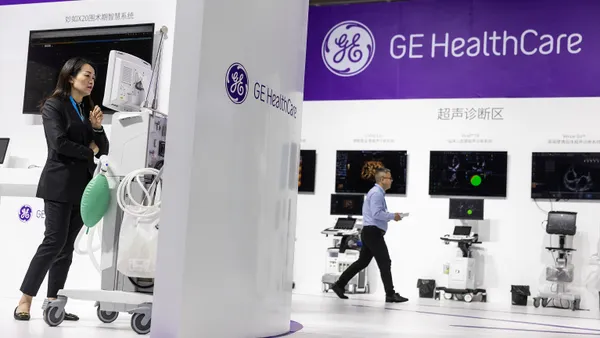Dive Brief:
- FDA will soon convene its Orthopaedic and Rehabilitation Devices Panel to gather input on the reclassification of noninvasive bone growth stimulators from Class III to the lower-risk Class II category, the agency said in a notice filed Friday.
- During the April 23-24 meeting, the panel also will discuss proposed Class II designations for four device types currently unclassified because they came to market before the 1976 medical device amendments to the Food, Drug and Cosmetic Act. That list consists of facet screw spinal systems, semi-constrained toe joint prostheses, intra-compartmental pressure monitors, and intra-abdominal pressure monitors.
- FDA’s device meeting calendar also includes public workshops on: the evolving role of artificial intelligence in radiological imaging (being held Tuesday and Wednesday this week); detecting circulating tumor DNA for cancer screening (March 9); use of patient preference information in medical device regulatory decisions (March 31); and the role of computational modeling and simulation in regulatory evaluation of health technologies (April 13-15).
Dive Insight:
Class III medical devices must follow the premarket approval (PMA) pathway to reach the market. If external bone growth stimulators are reclassified as Class II devices, manufacturers of the products would be able to pursue the less arduous 510(k) route to FDA clearance.
Noninvasive bone stimulators deliver ultrasonic or pulsed electromagnetic waves that stimulate healing. The treatment involves applying the stimulator to the skin over the location of a bone fracture for a period of time each day. Companies that make the devices include Zimmer Biomet, DJO and Orthofix.
During the April panel sessions, FDA will also evaluate proposed Class II designations for facet screw spinal systems, semi-constrained toe joint prostheses, intra-compartmental pressure monitors, and intra-abdominal pressure monitors. The reclassification process for pre-amendment devices has been going on for a number of years.
Prior to the orthopaedics devices meeting, FDA has a number of upcoming public workshops as soon as this week.
On Tuesday and Wednesday, the agency will discuss benefits and risks of AI applications in radiological imaging including devices for automating diagnostic radiology workflow and image acquisition. The meeting will also address best practices for validation of software.
The March 9 cancer screening workshop will focus on determining the best regulatory framework for developing diagnostic tests based on use of circulating tumor DNA in asymptomatic patients. Challenges include determining the optimal clinical study design for the tests and what data are needed to assess whether the benefits of such tests outweigh the risks.
On March 31, an FDA workshop will explore potential applications and challenges in the use of patient preference information in regulatory decision making for medical devices. The forum will cover the value of the information in various settings, case studies, and methodologies for collecting the data. A pre-event webinar, “Patient Preference Information – What It Is and What It Is Not,” will be held March 4.
FDA's April 13-15 event will gather input on the role of computational modeling and simulation in the regulatory evaluation of health technologies. The agency notes that computational modeling has become an increasingly useful tool for evaluating medical devices, complementing traditional bench testing, in vivo pre-clinical studies and clinical trials for generating evidence prior to marketing medical devices.










